This post may contain affiliate links. Please read our disclosure policy.
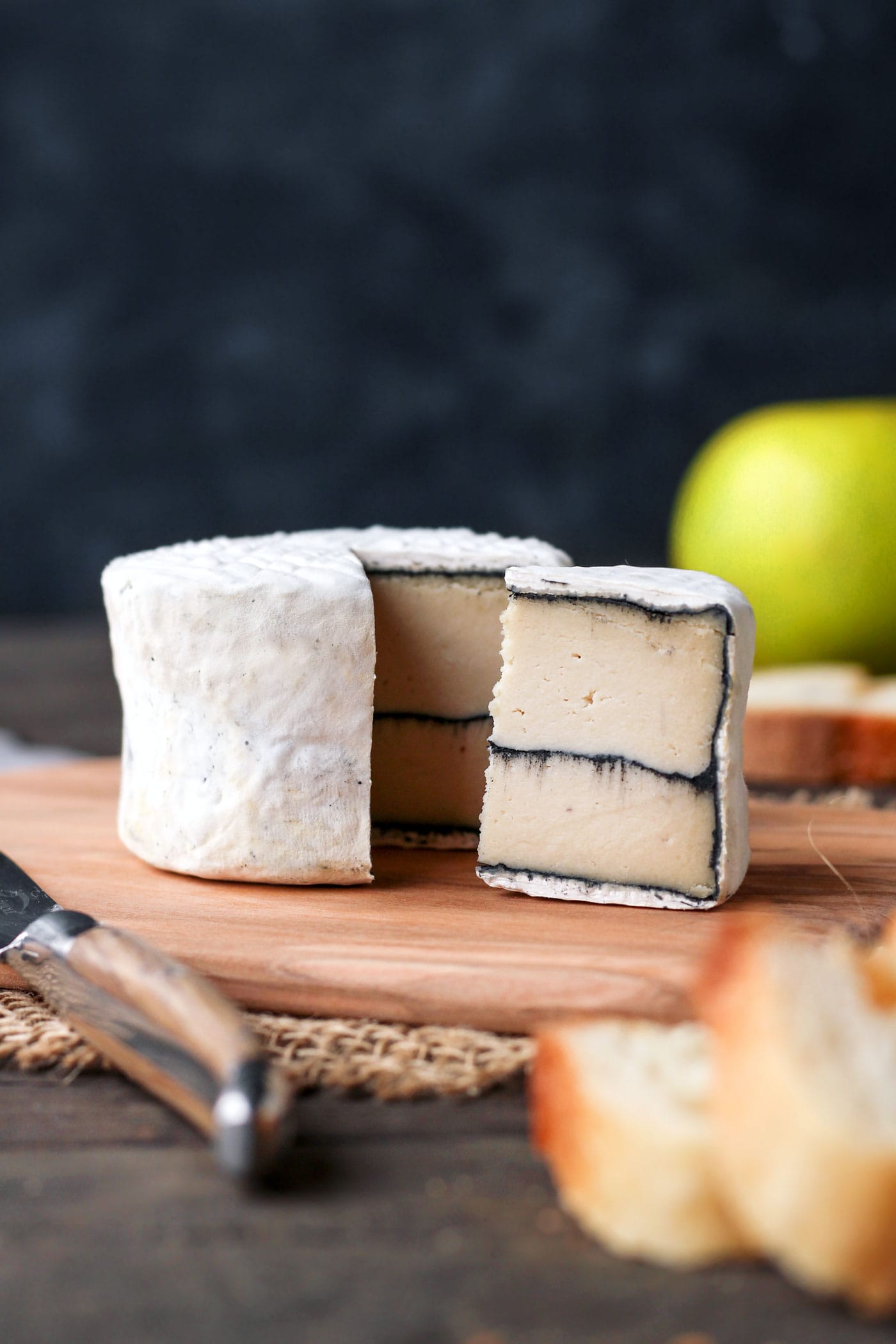
Back at it with another vegan cheese! Vegan Ash-Ripened Camembert!
As explained in the post last year, I was disappointed to see many people making my cheese recipes and not giving any credit, or even worse, claiming they created the recipe themselves. Some people went even further, trying to sell it through their business to customers. I can say that because they used the same “scramble” technique I created to have large blue veins inside the blue cheese.
Many of you sent me support emails at this time, and I really appreciate it. I figured you guys should not be deprived of new recipes just because of a few people. I realized there is no copyright on vegan cheese making; it doesn’t belong to anyone. Ultimately, the goal is to promote veganism, and the more experiments we share, the further we can go. That’s why I’m working on new cheese recipes I will publish here soon. There are three in the works, so stay tuned!
In the meantime, I thought I would share a recent experiment. This is more like an alternative version of my aged vegan camembert than a whole new recipe. However, I thought I would still share it because the taste is a bit different. And doesn’t it look cool? And it contains only 6 ingredients!
This camembert is first coated with vegetable ash and then naturally covered by a white mold (Penicillium camemberti). It also has a thin black line in the middle to make it look even cooler, a bit like Morbier cheese.
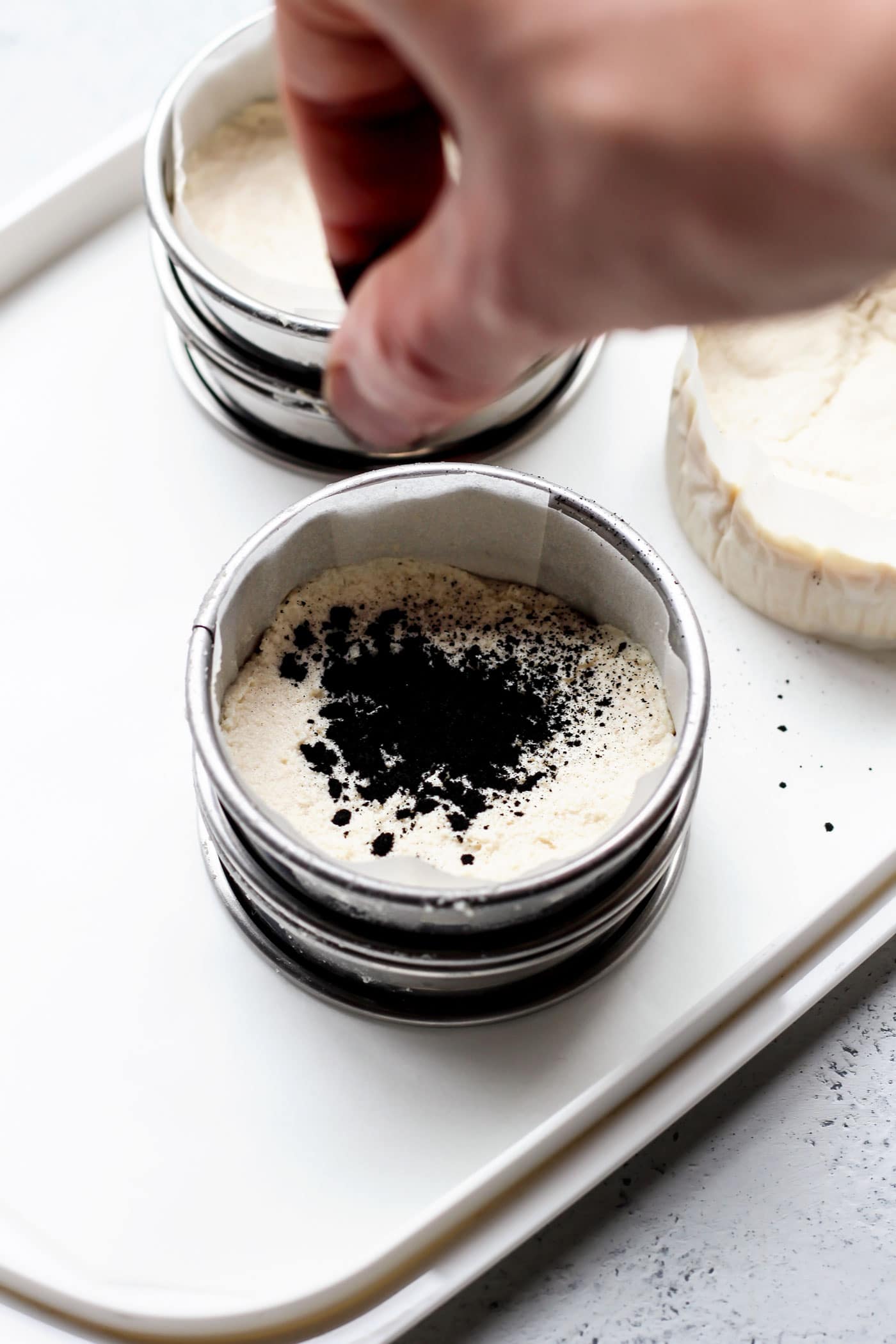
Vegetable ash (also called activated charcoal) is mostly used for aesthetics here, but it also helps lower the cheese’s acidity, giving it a milder flavor. The other advantage of using ash is that the white mold will grow quicker on the outside and prevent other bad molds from appearing.
I added some white miso to make the cheese a bit different taste-wise. It creates a more buttery flavor. Make sure to use a light one. Otherwise, it will be too salty.
Please check the links in the recipe regarding where to find the mold, cultures, and vegetable ash. If you are located in Europe, I recommend checking out cashewbert.com. They have everything you need to make all sorts of vegan cheeses, from cultures to supplies.

The technique is very similar to the one used in camembert cheese making, except you fill half of the molds with the cashew cream, sprinkle some vegetable ash, and cover with the rest of the cream. This creates a thin line in the center. For the exterior, you will use a mix of salt and ash. Salt will help the mold grow, penetrate the cheese, and add flavor.
After about 5-7 days, you should start to see some white mold growing on top of the ash. Now things are getting exciting! As you continue to flip it once a day, the mold will slowly cover the whole surface of the cheese and completely cover the black ash.
Once fully coated, you can wrap it in cheese paper and let it age for at least one additional week in the refrigerator. Complex flavors will develop, and the cheese will be then ready to eat.

The ash makes this cheese unique and will definitely surprise your guests once they cut through it and take a slice!
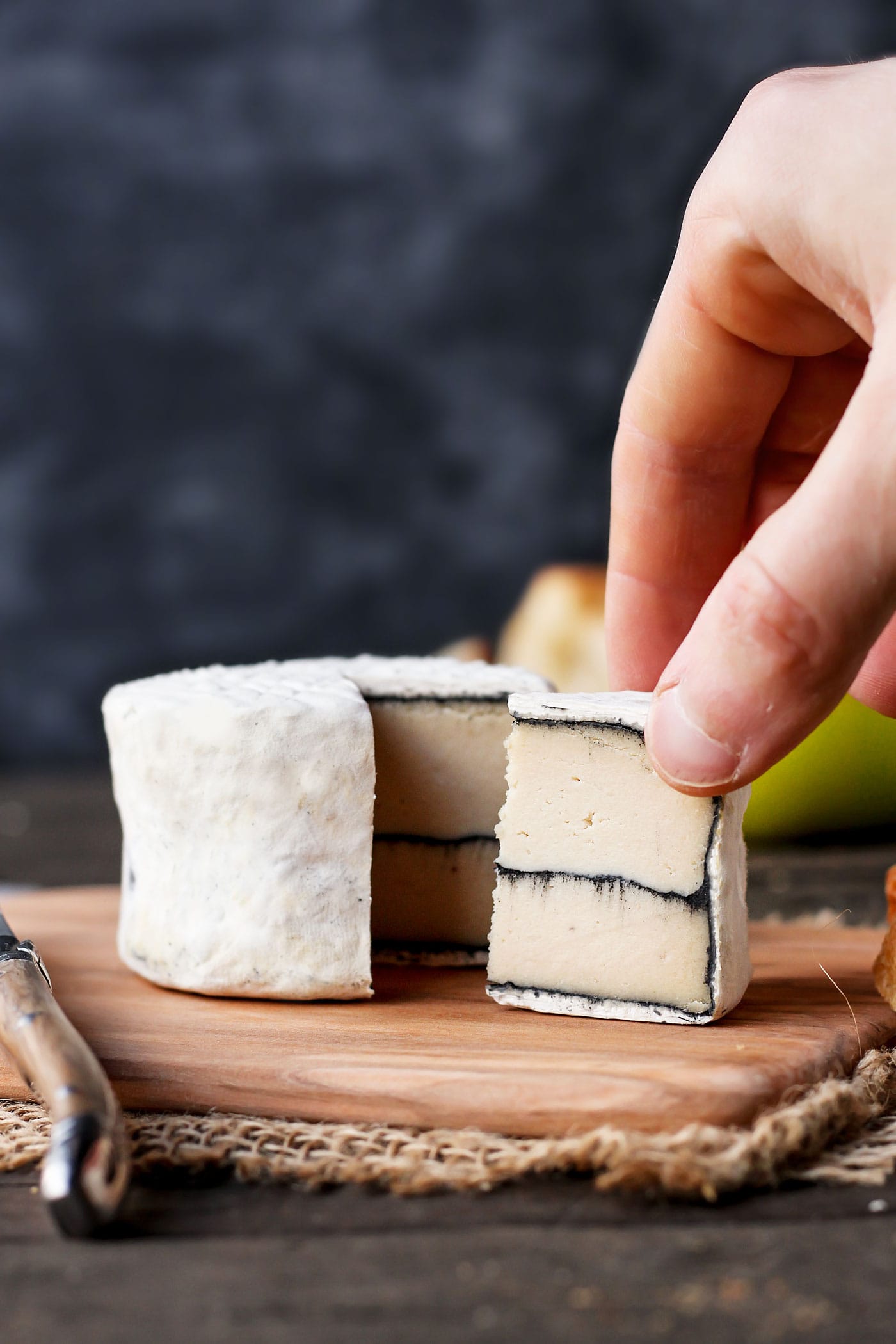
This vegan ash-ripened camembert would make a great addition to a vegan cheese platter with camembert, blue cheese, and hickory smoked vegan cheese!
If you have questions, please check out the comments on the vegan camembert post before. There is a lot of useful info, and questions answered.
As always, let me know in the comments if you try this recipe!
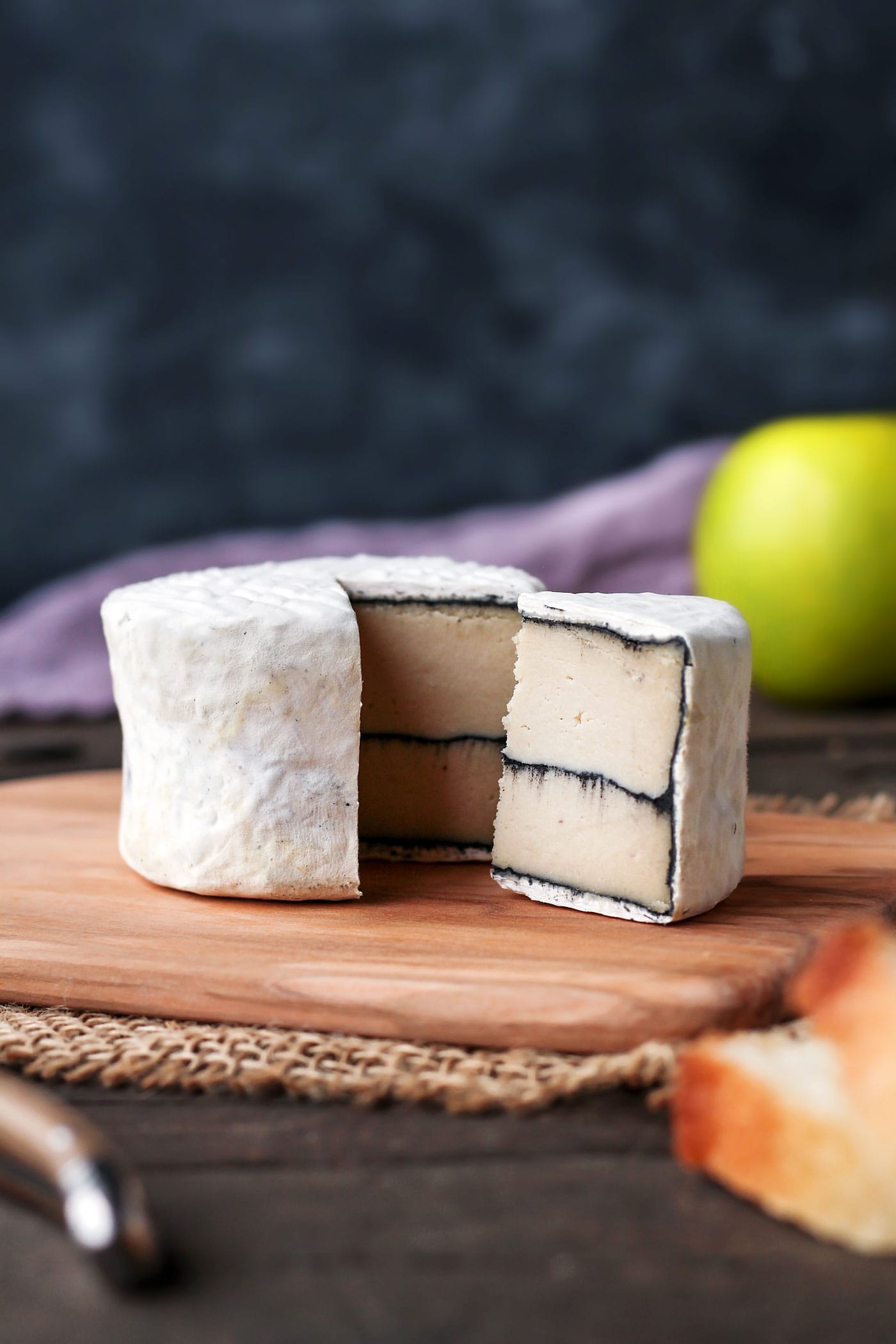

Vegan Ash-Ripened Camembert
Ingredients
- 3 cups raw cashews
- 2-3 tbsp filtered water or bottled water
- 1 tbsp light sweet miso
- 1/8 tsp mesophilic culture or 6 capsules acidophilus
- 1/16 tsp penicillium candidum
- 2 tbsp vegetable ash activated charcoal
- 2 tsp sea salt
Instructions
Cashews
- Soak the cashews in filtered water for at least 5 hours or overnight.
Making The Cheeses
- Drain the cashews and place them in a large bowl. Bring a large pot of water to a boil, transfer the boiling water to the cashew bowl, and let sit for 1-2 minutes. This step will help kill viable bacteria.
- Drain the cashews and place them in the bowl of the blender (or food processor) with the miso and 2 tbsp water.
- Blend on high speed, scraping down the sides from time to time, this step might take about 10 minutes depending on your blender. You want a very smooth yet thick texture. If needed, add 1 tablespoon of water at a time until smooth. Do not add too much water, you want to use as least as possible otherwise the cheese will be too soft.
- Open the probiotic capsules and add the powder to the bowl. You can use a mesophilic culture starter instead if you prefer. Both will work. Blend for a few seconds.
- Add the penicillium candidum and blend for another 10-15 seconds. If your penicillium candidum is in liquid form, use about one drop.
- Transfer the mixture to a cheesecloth and pull it tight. Add a weight above it and let it sit at room temperature for 10-12 hours. I placed the cheesecloth in a colander on top of a bowl. This step is important to start the fermentation of the cashew cream and drain possible excess water.
- After about 12 hours, the cashew cream should have a slightly sour taste, like fresh cream cheese. Transfer to a clean bowl, cover with plastic film to touch and place in the refrigerator for about 4 hours. It will make the cashew cream easier to work with.
- Cut strips of parchment paper and lay them in 3 small springform pans (I used two 3-inch cookie cutter rounds, stacked to make it taller). You want to cover the sides and bottom of the springform pans. You can also use plastic film if you prefer. The goal is to prevent the cheese from touching the metal. Fill half the pans with the mixture and press it down using plastic film so it doesn't stick to your hands. Make sure the surface is flat.
- Sprinkle a bit less than 1/4 tsp of ash on top of the cashew mixture and spread lightly with your finger. Don't add too much ash, you want a very thin line. Otherwise, the other half of the cashew cream won't stick to the bottom one.
- Finally, top the ash with more cashew cream, filling the pans to the top. Press it down firmly using a plastic film or latex gloves. Cover the pans with plastic film to touch and place in the refrigerator for 24-36 hours.
- After that, prepare the ash mixture: in a small bowl, mix 2 tbsp vegetable ash with 2 tsp sea salt. Carefully remove the cheeses from their springform pans and salt on both sides with about 1/4 tsp of the ash-salt mixture. Do the same for the sides. Shake each cheese a bit to remove excess ash.
- Line a clean baking sheet with parchment paper. Place each cheese on the baking sheet and cover with glass or plastic containers. This is essential to keep enough humidity and allow the mold to grow. Place the baking sheet in the refrigerator. I recommend setting the temperature of your fridge around 48-52°F.
Aging
- Every day for the next 4-5 days, carefully flip the cheeses. The cheeses will still be very soft, like cream cheese. Don't worry. They will be easier to work with after a few days. If droplets form inside the containers, drain them with a paper kitchen towel. If the parchment paper becomes too wet, change it.
- On day 5, move the cheeses to a bamboo mat or clean a thick grid. Keep them covered during the whole process.
- Continue to flip the cheeses daily for the next 7-10 days. Always use clean hands or work with a plastic film to be sure you are not touching the cheese. The mold will start to appear on day 8-10, depending on the humidity and temperature of your fridge. After another week or so, the cheeses should be fully covered with white mold.
- Once they are completely white, wrap the cheeses in parchment paper or cheese paper and place them in the refrigerator for at least 5 days. The longer you let them age in the refrigerator, the stronger the taste.
- Enjoy with French bread, nuts, and/or drizzle with maple syrup!
- The cheese will keep for at least 1 month in the refrigerator.
Notes
Nutrition

About the Author
Thomas Pagot is the founder, photographer, and recipe developer behind Full of Plants. He created the blog in 2016 as a personal cookbook for vegan recipes. Through years of recipe development, Thomas has successfully grown Full of Plants into a trusted resource for plant-based recipes.
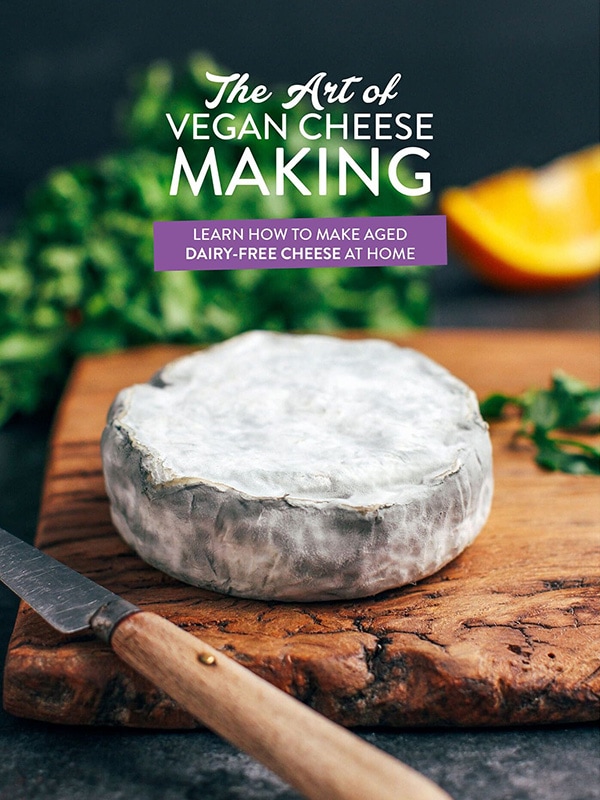
🧀 25 Mind-Blowing Vegan Cheese Recipes!
Sign up for the Full of Plants newsletter and you’ll get new recipes delivered by email weekly, PLUS your FREE 100-page printable eBook!




You are such a star, Thomas! This looks beautiful and I am sure tastes amazing. Well done and thank you for sharing with us!
You’ve done it again!! I have to try making one of your amazing cheeses these days! You should really start a vegan cheese company!!
You should definitely try it, it’s a fun project!
Thanks Sam 🙂
Wow!!! I wish I had some of that right now. Innovators will always be copied – and you are an innovator – thank you!
Thank you Patricia!
Hi Thomas. Yet another gorgeous-looking recipe. I was intrigued by your comments RE: others selling cheeses thanks to your recipes. What would you prefer them to do? I am not a seller, FYI. However one day I might wish to and would like to avoid offending anyone especially if s/he had generously contributed to the Commons. Best wishes, Lz
Hi Liz, thanks! 🙂
Nothing at all! The thing is when I released the recipes last year there was not a single similar recipe available online. Then I saw a few people posting photos of their cheeses without giving credit, that happens but the thing that shocked me the most is when some people asked them how they made it or if they could share a recipe, they didn’t reply or just said “they were still working on it”. So at this time, I got a bit irritated they wouldn’t share a simple link to the recipe with others who wanted to make it too.
A few blogs also released a recipe with exact same steps, measurements, and ingredients, nothing changed. Regarding the ones who tried to sell it, it’s another story for another day 🙂 I’m not sure why, but in the end, they quickly stopped.
Anyway, if you do plan to make and sell vegan cheese, it’s great! The more variety the better. As I said in the post, I also realized vegan cheese making techniques will always be similar in one way or another. Vegan cheese is still in its early stages and there are very few vegan cheese makers right now, I guess that’s probably why we are still focusing so much on who created this or that first.
Surely you could licence it under creative commons? CC to allow people right to use with acknowledgement required but not monetise it. You don’t need to have invented cheese making but after all, you did research and invent the process with raw nuts. If it turns out someone else came.uo with the exact same approach before you, that’s OK, it would be easily for them to prove it (these days everyone takes a photo etc).
I think you should go creative commons. Before you know it, a huge food company will be selling your recipe globally for profits for their rich shareholders
Hi Thomas
I did it! It’s delicious. Not looking like yours but the taste OMG! Thank you!
Looks delicious . But I can’t eat soy
Can I do it without the miso ?
Hi Patty,
You can definitely do it without the miso! Or use chickpea miso instead if you can find it.
Good luck!
Dearest Thomas . . . I refer to you as “Dearest” because, even though I have only discovered you and your SPECTACULAR-looking cheese creations, I can already tell you are one of the DEAREST types of people whom I adore in my life, and therefore, to me (and I can see by some of the comments on your site), to MANY others as well. You are “dear” to me because you are being so kind, loving and generous to post your recipes, to “spread the love” as they say, and I just think that is a wonderful, sweet, and thoughtful thing to do.
To those people who would USE your recipes and your processes and NOT give you credit, even, in some cases, to actually CLAIM they were their OWN creations and ideas, well dear Thomas, I would call those people “ABSOLUTELY DESPICABLE”! I can never understand that kind of not only HORRIBLY DISHONEST, but also selfish, greedy and disgusting mindset in our world, nor can I EVER understand that level of a lack of INTEGRITY. After all, we are ALL in this boat (this life on this planet) TOGETHER, and I wholeheartedly believe in “giving credit where credit is due”. EACH one of us has something unique and special to give in this world (AS WELL AS to this HEALTHIER and VEGAN world to which many of us adhere, myself included!), and there is room for ALL of our unique contributions, without having to resort to such terrible STEALING!! Those people who do that are, I suppose, to be PITIED more than anything else, but it also just INFURIATES me.
So, our Dear, Loving, Generous, Brilliantly Creative and UNBELIEVABLY AMAZING AND TALENTED Thomas, I just HAD to write this to you to add my little bit to the many supporters you have, and thank you, PERSONALLY, for what you are doing, and how LOVINGLY you are doing it. Don’t let the rotten eggs spoil the BEAUTY of your character and your creativity.
I am writing a cookbook (SOME DAY it will be finished…I’ve “only” been working on it for 27 years!!!…hahaha!!….actually, 27 years ago is when I FIRST began creating the specific kinds of vegan recipes in which I specialize, but I only got HALFWAY serious about turning them into an actual cookbook a “mere” 8-10 years ago or so!). I want to encourage YOU to create a cookbook of your cheese recipes, because, although you’re correct that we cannot copyright the actual recipes in a cookbook, according to what I know about it, you CAN copyright ALL of the MATERIAL surrounding those recipes, such as your “crumbling” technique for the blue cheese, etc.!!!…..the PROCESS you go through, which is laid out specifically in your recipes, plus any other TEXT you compose surrounding those recipes, IS, I believe, copyright-able, which is why ALL published cookbooks (whether self-published or otherwise!) are, in fact, copyrighted. So that would be at least SOME protection for your “babies” (your wonderful creations!!!)……I’m not sure whether or not you can do that sort of copyrighting on a blog such as yours, but it would be worth looking into. And if I find out any other information, or sources for you to check out on the matter, I will MOST CERTAINLY pass any and all of that info on to you!
Anyway, I’m sorry to take so much space here with these comments, but I wasn’t sure how else I could communicate my feelings to you, and I also thought my words might strike a chord with your other readers (if they suffer through this LOOOOONG comment…haha!), and maybe even help to DISCOURAGE some possible “plagiarizing” (i.e., STEALING!!!) of your material.
Keep on creating, Thomas!! Don’t let the “evil people” stop you . . . but also, think about finding a way to protect yourself wherever and however you can, AND protect your creations as well, while still “spreading the love” in our vegan community as you are doing!!
Very sincerely, and honestly….
….one of your newest (but already MOST ardent and loyal) fans….
Daryl Grant Lindsay
PS: I’ve not yet attempted making any of your recipes, although I intend to do so, however, I ALREADY have given this newest recipe of yours, the “Vegan Ash-Ripened Camembert” a GLOWINGLY FIVE-STAR RATING, because I have SUPREME CONFIDENCE that it is, indeed, 5-star!!!! Thank you so much for sharing this and all of your other creations. You are simply wonderful!!!
PPS: I wanted to let you know that I heard about you and your creations via YouTube and “Kari Eats Plants”……In case you didn’t know about her, she goes through the process for making your vegan bleu cheese and then, at the end, she says, “This is NOT my own recipe . . . ” (or something like that), and then she names you and gives you FULL CREDIT for it, even showing your website mast-head, complete with your photo, and telling people to “give THOMAS the love”!!!! So it is thanks to Kari that I know about you (I only just discovered her YouTube channel 2 days before!), and I plan on writing her and THANKING her, personally, for informing me about you and your creations, AS WELL AS for being honest about the recipe! I just thought you’d like to know that, so you know that EVEN ON YOUTUBE (fancy that!!..haha!), there ARE some good, decent, loving people!!!
OOPS!!!….I forgot to include that “premature” rating which I KNOW will be 5-star!!!!!
Thank you so much for your message, Daryl!
Wow working for a decade on a cookbook is such a long time, that’s amazing you are taking this amount of time to perfect your recipes. I wish you a good book launch (hopefully happening soon!). Feel free to leave a comment here once it’s released so I can take a look 😉
I didn’t know about this video from Kari Eats Plants, thanks for sharing! I can’t imagine how long it took her to film each and every step, incredible work! 🙂
So happy to hear that you’ll be providing us with more of your amazing cheese recipes in the future! 😀 I’m still looking forward to a washed rind cheese, if anyone can do this, it’s you!
Keep your tail up, there will always be stupid people, but we here know who the original, cheese-making genius is: YOU!
Last weekend I surprised the sweet potato loving husband with your köfte. He was in heaven 🙂
Thanks Anja!
Washed rind is a bit difficult but I’m still working on it.
So glad to hear your husband liked the sweet potato köfte! 🙂
Have you tried using ABL or Neige Penicillium Candidum instead of HP6 for either this cheese or the Aged Camembert? I am currently unable to order the HP6. Would either of the other two work if I just let the cheese age longer? If I understand correctly, they are slower to mature. Would the flavor be different? Any recommendations or advice?
I did, both work great! Regarding the flavor, I didn’t taste any difference. Penicillium Candidum Neige makes a slightly thicker rind though.
You’ve done it again! You’re a culinary genius, Thomas.Thank you for sharing 🙂
Now, if only I had the patience and time to make this cheese… 😉
Thanks Marie, you have to make it! Time goes by so fast!
Seems a real shame that some people wouldn’t reference and share your recipes, they’re definitely some of the best I’ve seen! I can’t wait to try some. Money’s currently a bit tight but looking forward to getting a bit of equipment to try in a couple of months. I mainly wondered what sort of blender/food processor would be best? Would you reccomend a specific power/shape/blade type that would get the bits really creamy. Hope you keep up the amazing work, it’s inspirational!!
Thanks John! I am using a Magimix 5200XL, not sure if it’s available in the UK but it’s a great brand and I never had any problem with it. It always makes a smooth cashew cream.
Regarding the blender, I’m using the Magimix Blender, great for making nut butters or smoothies 😉
Thank you Thomas!!! These cheese recipes look wonderful. I was never much of a dairy person EXCEPT for my love of brie and camembert. So thanks a million for pioneering this process for us.
I was wondering if you’ve used PC in conjunction with a geo strain. I saw that it was recommended to help the PC bloom so I picked some up. Just got my cultures today so I’m super excited to start this!!! I haven’t ordered my ash though. Guess I’ll have to make a second batch 😀
ALSO. I would totally buy a vegan cheese book from you. You deserve credit for what you’ve done here. Shame on the jerks who try to pirate your hard work without citing it. Also also, you are working on washed rind cheese now, yes? Would Muenster happen to be one of them?
You’re welcome Jane!
Yes, I have used geotrichum combined with PC a few times in the past. It helps improve the taste, but unless you have the perfect aging conditions there are great chances you will see other molds developping as well. Lately I don’t use it anymore for camembert, because if you have just a bit too much humidity in your fridge/aging room for example, blue mold tends to grow before PC.
That’s correct, and washed-rinds are not an easy one. I never tried Muenster so I won’t be able to say if it will have a similar taste, but stay tuned!
This looks amazing!! Do you have to use Penicillium Candidum for it to work or would Mesophilic work too?
Thanks Mary! Yes you do have to use Penicillium Candidum mold to get the white rind, mesophilic is the culture that will make the cheese taste tangy.
Hi, Thomas,
Thank you once more for the recipes, especially these fabulous cheeses. Now these are the favorites of my family and some friends who also do not use dairy.
By the way, I spotted a nice tutorial on making almond milk ricotta here https://www.youtube.com/watch?v=vxw-41grWuw
Now I am tempted to try to use that as a basis for the white mold cheese recipe you posted. Let’s see how they compare.
Regards.
Hi Vytautas,
Glad to hear you liked the recipes!
Regarding the ricotta, I made several tests with lemon juice and never liked the results. I have been using transglutaminase enzyme lately to curdle fresh almond milk. The taste and texture are a lot better than with lemon juice, but still, you don’t a satisfying mouthfeel (because of a lack of fat) and they turn too sour quickly.
May I know how come the cheese can’t touch the metal springform? Thanks!
If you don’t use parchment paper the cashew cream will stick to the metal springform pans, cheeses won’t be very easy to remove from the pan.
Hello Thomas.
It’s been 6 weeks now since I made the cheese. It’s covered completly with nice white mold, but very very soft inside. I cut one to check. I wrapped it with special papper for cheese…but not sure if it’s the right thing to do,, since, again, the cheese is soft to the point that when you cut it, it gets mushy.
Thank you for teaching us so much
Vita
Hi Vita,
My guess is that you used a bit too much water when blending the cashews, in my opinion it’s not a bad thing actually. If you let it age 1-2 additional weeks it will be stronger in flavor, a bit firmer but still creamy, win-win 🙂
Yes, when the camemberts are fully covered by white mold it’s always a good idea to wrap them, there is no advantage of leaving them in contact with the air anymore.
I’m making this now with wild hazelnuts and charred leeks for the ash. It’s so amazing. Can’t wait to dig into it. Thomas, it looks like you use a wire mesh rack for your cheeses, with paper underneath. At what point in your culturing process do you use these racks? It would seem to allow airflow under the cheeses as well as all around. I use parchement paper and sometimes notice that the moisture gathers on it, and can help encourage other mold.
Saw a photo of your cheeses on Facebook 🙂 They look great Melissa!
I transfer the cheeses to a rack as soon as they are a bit firmer, usually when the white mold starts to appear (after 7-10 days). You are right, it allows the mold to grow more uniformly and quickly than if it’s on a parchment paper. I still flip them every day though, or at least every two days, and they must be covered with a box or container. Regarding the racks, it’s just refrigerator racks that I cleaned very well.
Can’t wait to hear how it tastes with hazelnuts!
Hello Thomas,
These cheeses look incredible. Congratulations.
I did have a question. I am not a big fan of the coconut flavor in my cheese.
I was wondering if another oil/fat could be used instead?
What is the reason for using coconut oil? Other then the richness and flavor?
Thanks and look forward to hearing back from you.
Hey Domenico,
Thanks! I assume you are talking about the blue cheese recipe. In the recipe, I recommend using refined coconut oil since it has no coconut flavor. Coconut oil helps in the ripening process, as the blue mold needs a bit more fat than penicillium candidum for example. It also makes the cheeses richer and helps to handle them at the beginning (coconut oil will firm them up a bit).
Hi Thomas, I am wondering how you handle the skin that forms during the initial 12 hours in
the cheesecloth. I decided to ignore it and proceed as per your recipe. I hope it works out.
Thanks
Hi Bianca,
Good question. I usually remove it, but lately I have been covering the cashew cream with plastic film and I don’t have this problem anymore. I will update the recipe to make this step clearer.
Don’t worry if you left it, it won’t affect the aging process.
Hi Thomas, thanks for the reply. So, from what I understand we wrap them in cheesecloth to
let some of the moisture come out and make the cheese a bit firmer. Won’t covering it in plastic
wrap prevent the release of moisture?
Thanks again,
Bianca
Wrapping the cashew cream in a cheesecloth is useful if it is too liquid. If you only used a few tablespoons of water and the cream is already thick, you can simply transfer it to a clean bowl and cover with plastic film to touch. Again, I will update the recipe to make this step clearer.
Hey Thomas! Love your recipes. I am currently making both your camembert and the blue cheese recipes. However, while set apart, I mixed up which is which! As I made two loaves of each cheese, I want to have a go at putting ash on my Camembert. Since I cant tell which is which, would it be okay if i ash one of the camembert and one of the blue? Would the ash/charcoal hinder the blue cheese’s growth? Should I just try next time?
Thank you so much for your innovation and your kind sharing with the vegan world!
Hey KK,
Haha 🙂 You should have used different size molds!
I guess you could do that, put ash on one cheese of each batch. I have no idea how it will work with blue cheese though. In my opinion, it won’t prevent the blue mold from growing as penicillium candidum grows above the ash, so you should be good.
so excited to try this version of the camembert! Have made all of your other cheese recipes and can say unequivocally that you are truly gifted! Thank you for your tenacity, and perseverance to perfect these amazing recipes!
Thanks Peg! I’m happy to hear you liked the other recipes 🙂
I made the Ash Ripened Camembert and the Vegan Blue at the same time, swapping almonds for cashews in both recipes and opting for acidophilus and omitting the miso since I hadn’t gotten my hands on a soy-free version at the time …I had to add a LOT more water with the almonds to get them moving in the Vitamix…I compensated by straining through cheesecloth-lined sieves before culturing. I had early indication that there was some bacterial contamination, so I wasn’t too disappointed at the end when I had to toss them, but I did go through the process just to see how the recipes behaved with the almonds…I am happy to say that they looked amazing and worked out well, just like the pictures…just not edible due to some pink bacteria growing on the cheese between the ‘skins’ and the cheese. Great learning project, thank you so much for the inspiration (your beautiful photos) and for sharing your recipe! I will be trying again soon, with some tweaks:)
Hi Amie,
Thank you so much for the feedback! Next time, make sure you pour boiling water on the cashews to kill possible bacterias and use super clean tools/equipment. It will reduce the possibilities of having bad bacterias growing.
Hi there just discovered your website, just wanted to suggest you make a cookbook with all your cheese recipes. Xx keep up the hard work xx michael
I still think you’re a genius Thomas! You certainly can write a book of recipes – then they’re on the record and your intellectual property! You can sell your brand as opposed to profiting off your brilliant recipes. You’ll have ethical sponsors queueing up in no time. Love your work, thank you!
Thanks for the kind words Kerri! 🙂
For those allergic to nuts, is it recommended to use garbonzo beans or other white bean for the texture, etc?
I wouldn’t recommend it, garbanzo or white beans don’t have the same fat content. I have never tried, but the cheeses probably won’t be as creamy and I’m not sure how the mold and cultures would react.
Made the blue cheese and it was fantastic! I even froze some and am having it this evening— a month or so later — and it’s wonderful…
Hope you’re working on a feta!
Thanks.
Awesome! So happy to hear you liked this cheese recipe 🙂
Thank you so much for these recipes; I can’t wait to try them out. As far as people/ companies stealing your recipes. I wonder if this is why Kite Hill stopped making their version?
You’re welcome! I don’t think so, I’m not sure why they stopped selling their camembert-style cheese.
If publishing your recipes on the internet doesn’t constitute intellectual property (as it should) then putting your recipes together in a booklet does. Just collate them, put them in pdf with your name on it and it’s your intellectual property. Someone else can do this then may direct YOU to stop using ‘their’ recipes. To safeguard them, just document. You should be able to prove it’s your work due to publication date/data chain if challenged, but why not publish. Placing my order for your fabulous book now please! (PS, you can self publish, however if you put a pdf together, you can sell it again and again and again – no doubt a publisher will seek you out. No doubt – unless someone beats you to it.
An ebook is coming soon Kerri 😉
Hi Thomas, first of all, you are a genius. I love your recipes!
I am very sorry that there are people taking advantage, but very happy that doesn’t stop you. People can only copy that much, you are the chef here 🙂
I would like to make this cheese and wondered if activated charcoal (which I have) is different than volcanic ash? I can order from cashewbert as I am in Europe, but if I have what I need than I prefer of course not, as it’s still an extra cost. In any case I will let you know the outcome!
Also, do you have any advice on how I could make a “blue” camembert? So using the 2 different molds, but only having a white rind. I have been thinking about this a bit now, but not really sure how to mix them.
Thank you so much for all you do. You brought my favourite cheeses back in my life.
Hi Diane,
Thanks for the kind words! There is a difference yes as one is “activated”, but for this particular recipe it won’t change anything, so feel free to use what you have one hand.
Regarding the blue camembert, I’m working on a recipe. I made several tests but still don’t have anything to share yet as I’m not fully happy with the results. It’s getting better though, so stay tuned!
Thank you so much! I will let you know how the cheese will work out 🙂
And yes blue camembert is my dream, so I will definitely stay tuned.
Sensational recipes. So glad that you are sharing them with us all.
You’re welcome Boguslawa! Thanks 😉